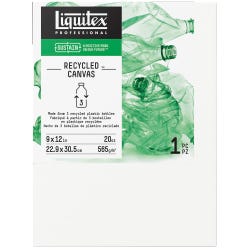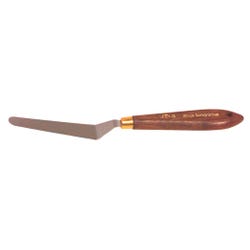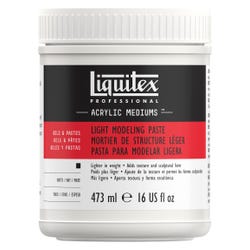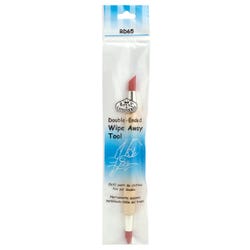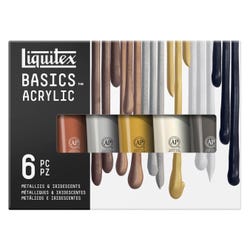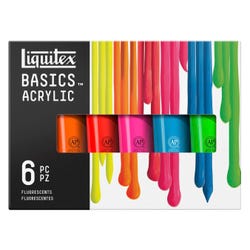Metallic, Iridescent, and Fluorescent! Oh My!

Description
Lesson Plan and Artwork by Phyllis M. Annett
Students will be challenged to capture the brilliance and shimmer of the Liquitex® Iridescent, Metallic, and Fluorescent Acrylics by creating a “seascape painting” depicting a shoreline bird or animal as a subject. The result will be a work of art that is “over the top” with color effects! The lesson also enables students to see the relationships and applications of art to the fields of science, art history, and history.
Objectives
- Realize that color in nature is essential to the survival of a species.
- Research, study, and sketch a specific marine bird or animal to be the subject of the painting.
- Gain knowledge and skill in painting techniques for metallic, iridescent, and fluorescent acrylics through firsthand experience with materials.
Supplies Needed
Liquitex® BASICS Metallics & Iridescents, 118 mL, Set of 6
Liquitex® BASICS Flourescents, 118 mL, Set of 6
Liquitex® BASICS Long Handle White Nylon Brushes, Set of 4
Liquitex® BASICS Coarse Texture Gel, 8.45 oz
Liquitex® Light Modeling Paste, 16 oz
Liquitex® Recycled Canvas, Traditional Depth, 9" x 12"
High-Grade Steel Flexible Palette Knife, 3"
Wipe Out Tool, Dual Ended, Set of 2
*Here are the supplies needed for this lesson plan for reference. Find a convenient carousel of shoppable products for this lesson below.
Standards
Standard #2: Organize and develop artistic ideas and work.
Standard #5: Develop and refine artistic work for presentation.
Standard #8: Interpret intent and meaning in artistic work.
Instructions
1
Inform your students of the project. Inspire and guide them through the progression of building a seascape acrylic painting.
2
Show students the work of Gustav Klimt (1862–1918), who used magnificent metals in his depictions of the Art Nouveau era. Iridescent, metallics, and fluorescents of the past and today have long intrigued people and have surfaced in artwork all over the world. Cite the metals used in the death mask of King Tut: gold, bronze, copper, and silver. Show students famous works of art, depicting the use of metals in artwork from all over the world.
3
Photos of the shoreline will help students depict the ocean and how it changes the colors of the sand and surf as the light changes. There is sparkle and shimmer in the ocean, and the Liquitex Metallic, Iridescent, and Fluorescent Acrylics can help students depict it. If possible, have students take photos of the shoreline and its inhabitants. Use technology that you can access and find examples of metallics in art.
4
Make time for students to select and sketch the subject or subjects of the “seascape,” such as seagulls, turtles, sting rays, seahorses, crabs, ghost crabs, snails, fish, dolphins, pelicans, etc. Students will research how color is key to the survival of a species.
5
Review the elements and principles of art to utilize them in the development of the balanced composition (the building blocks of the painting). Students will use these as reference tools only.
6
Have students experience Liquitex Metallic, Iridescent, and Fluorescent Acrylics by experimenting with color mixtures and creating color and tint charts on sheets of canvas. Discover what effects can be gained by experimenting with them and on this example Liquitex BASICS Colors are used, mixed with the metallics as well as under and over them.
7
Start the painting on the Liquitex 9" x 12" stretched canvas. Use an underpainting directly on the 9" x 12" stretched canvas with a muted blue or ochre shade to add depth to the work.
8
Next mix Liquitex Ultramarine Blue Acrylic with water. Use the mixture to block in lights and darks directly on the canvas. Refer to the composition sketch placement of parts of the picture. Remember to work from the background to the foreground.
9
Start building the seascape by using various painting techniques such as overlays, textured surfaces, translucent color fields, dry brushing, and surface finishes such as glossy, satin, or matte. Put colors over one another and over regular colors as a base.
10
The iridescent paints are transparent and make for good veiling or overlaying of color. Two iridescent paints when mixed will cancel the shimmer effect out. Enjoy the painting process. Allow areas to dry, especially if you want to create overlaying of iridescent and fluorescent acrylics.
11
Tips for Painting with Metallics, Iridescent, Fluorescents:
- The addition of Liquitex Gloss Gels will enhance optical brilliance of the colors.
- Iridescent colors can mimic metal. They can give depth to a translucent backdrop for layers of transparent color.
- If you add a small amount of Iridescent color to any other pigment, it will add radiance to the color to imitate gold, silver, copper, or bronze.
- Finely milled metallics can be used in airbrush tools.
- Iridescent paint can go from transparent to opaque, depending upon how much is on your brush. They are best viewed on top of a transparent color.
- Graphite Grey is best used over a white background. It can be brushed to a high scene, and it will glow under a black light!
12
Evaluate your work and that of others, and proudly display all work!



